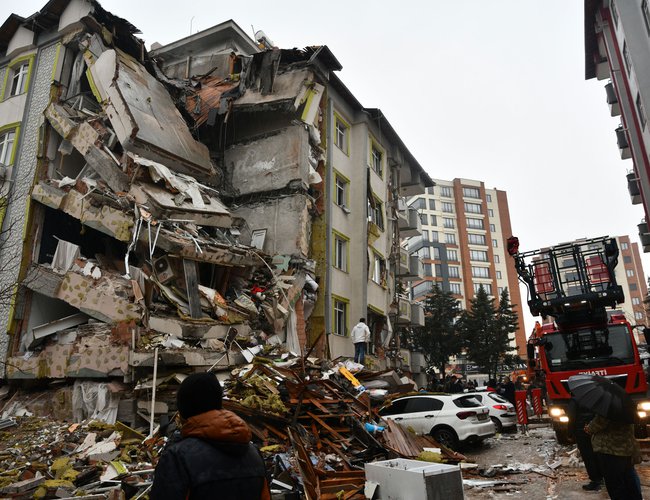
A seismic engineering expert in Japan has pointed to the so-called 'pancake' collapse of many buildings in Turkey as a key reason for the staggering death toll from this month's earthquake. The disaster claimed the lives of more than 33,000 people, many of whom were crushed or trapped as a result of catastrophic structural failures.
Kusunoki Koichi, a professor at the Earthquake Research Institute of the University of Tokyo, has spent time surveying buildings in Turkey, a country prone to regular seismic activity.
He says this month's magnitude 7.8 tremor caused many low-rise and middle-rise buildings to collapse instantly when their pillars gave way. "This is a very dangerous phenomenon called a 'pancake' collapse, where the entire building collapses downwards on itself."
What a pancake collapse is
Pancake collapses are so named for the way collapsing floors land and stack as they fall, said Gregg Favre, executive director of the St. Louis Regional Response Systems, a former commanding officer with the St. Louis Fire Department and experienced special rescue team member.
“Pancake collapses tend to ‘stack’ floors on themselves, bringing all their weight down nearly square on the floor below,” Favre told CNN. “This continues down, accumulating more weight and stress as the structure falls.”
A pancake collapse is a “progressive failure” that often begins at the bottom: A load-bearing element is damaged, usually in a building’s lower floors or foundation, which triggers the top floors to collapse vertically into the floors below, said Necati Catbas, a professor in the Department of Civil, Environmental, and Construction Engineering at the University of Central Florida.
“Once there is ‘no’ support at the bottom floors or foundation, the top floors start pounding on the from top to bottom in progressive manner,” Catbas said in an email to CNN.
Why pancake collapses occur
Pancake collapses occur frequently after major earthquakes, when tremors damage the load-bearing structures in a building or bridge. These kinds of collapses aren’t common in Florida, where buildings are much more vulnerable to wind damage than an earthquake, said Jeffrey Lindsey, a fire and emergency services coordinator and lecturer at the University of Florida.
Lindsey pointed to a notable example of a pancake collapse in Oakland, California: A 1989 earthquake caused the upper deck of a freeway to collapse onto the lower level, raining debris onto cars traveling below it, the Los Angeles Times reported at the time.
Why they’re dangerous
A pancake collapse is more dangerous than other collapses, Favre said, because there are often few voids, or pockets of space and air, in the rubble.
“The sheer tonnage of materials … makes it very difficult for void spaces to exist,” Favre said.
Pancake collapses also complicate search-and-rescue missions, he said, because the structures that remain near the collapse site are unstable and could fall as rescuers move through the rubble.
Voids can still be present, though, particularly when multiple kinds of collapses are present, as in the incident in Surfside, said urban search and rescue expert Scott Goldstein.
No time to escape
Violent shaking first causes the pillars of a multistory building to explode. That leads to each floor of the building falling and folding.
Professor Kusunoki says the reason why casualties are so high is that when a 'pancake' collapse occurs, people inside have no time to escape.
While the earthquake resistance building code in Turkey is the same as in Japan, many old buildings do not meet those standards. Professor Kusunoki says it will be crucial to look at the ages of the buildings that collapsed and the precise causes of the failures.
Japanese Experts view
Kusunoki Koichi, professor at the Earthquake Research Institute of the University of Tokyo/ He also notes that multiple housing complexes toppled over on the same side.
Professor Kusunoki says it's possible that major damage has occurred even in buildings that meet Japanese seismic standards.
"Although Japan's seismic diagnosis and reinforcement are progressing, there are still buildings that were designed according to old standards. It is very important to keep working on seismic reinforcement."
Comparing against the Japanese scale
Earthquake engineer Shiomitsu Masafumi, an assistant professor at Yamagata University, has been analyzing seismometer data obtained from about 30 observation points in Turkey. The tremor occurred shortly after 4:00 a.m. local time on February 6.
Shiomitsu notes that the quake generated severe shaking equivalent to a seismic intensity of 7 on Japan's seismic intensity scale of zero to 7 in Hassa, Hatay region, about 60 kilometers southwest of the epicenter.
In recent decades, three quakes in Japan have generated the same seismic intensity: the Great Hanshin-Awaji Earthquake in 1995, the Great East Japan Earthquake in 2011, and the Kumamoto Earthquake in 2016. All three caused catastrophic damage.
Shiomitsu also reports that during the Turkey earthquake, shaking equivalent to a Japanese scale upper and lower 6 extended to a range of about 160 kilometers from the epicenter.
A drone image of earthquake ruins in the Turkish province of Hatay, taken on February 7.
He warns that tremors of that size could cause serious damage to relatively large structures, such as middle-rise buildings in Japan. "It's believed that very powerful tremors with an intensity of upper 6 to 7 on the Japanese seismic intensity scale, which can cause severe damage to buildings in Japan, were the reason for the extensive damage, but we need to confirm this."
Source: NHK and CNN
- Biden And Netanyahu Discuss Gaza Ceasefire
- Jul 26, 2024
- Paris Olympic Will Start On Saturday
- Jul 25, 2024
- IOC Names Hosts Of Winter Games
- Jul 25, 2024
- 85 % Paddy Plantation Completes Nationwide
- Jul 24, 2024
- Kamala Harris Hits Presidential Campaign Trail
- Jul 24, 2024
















